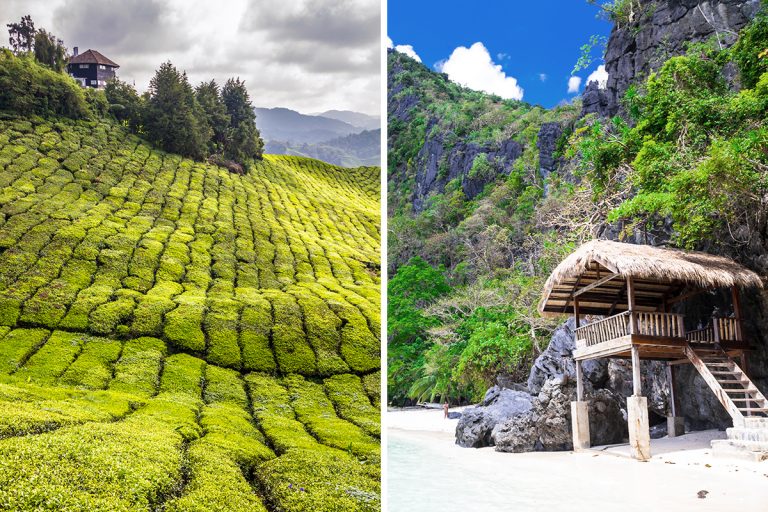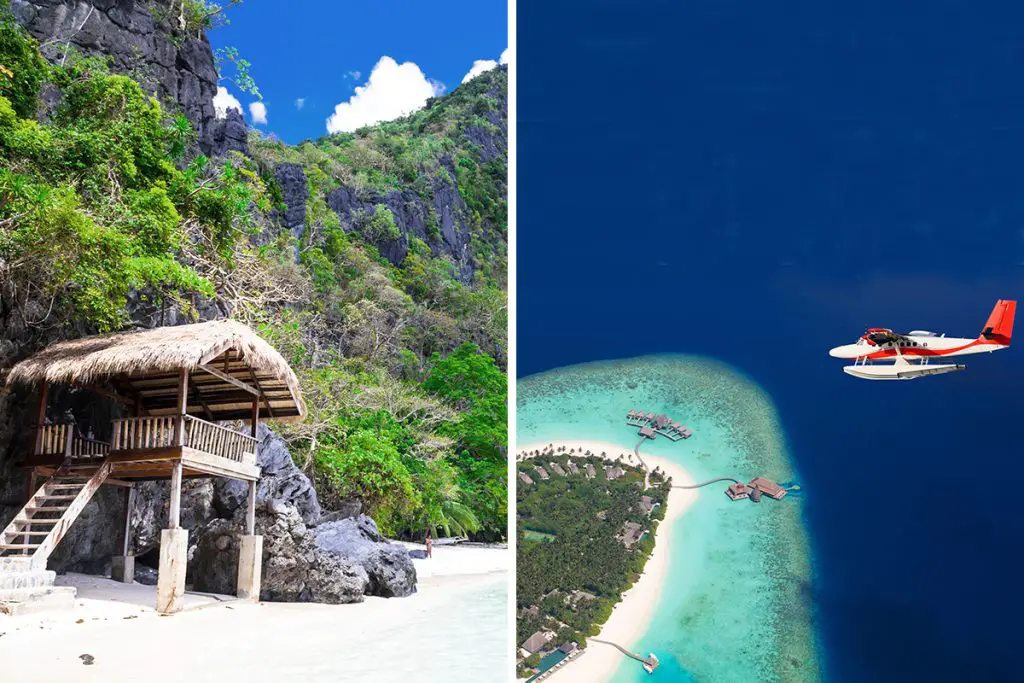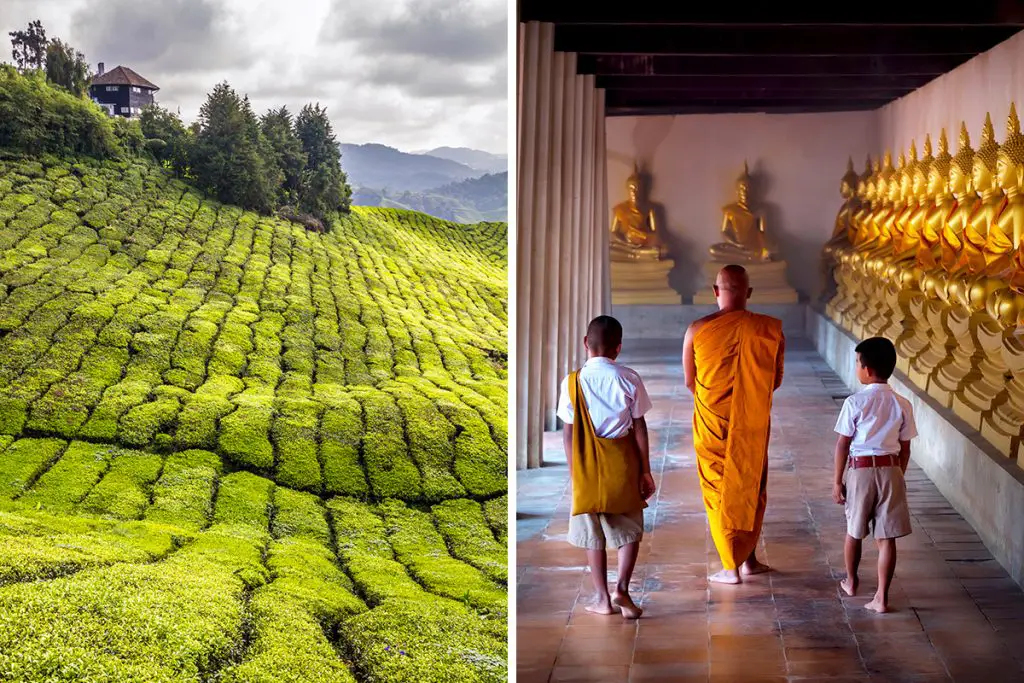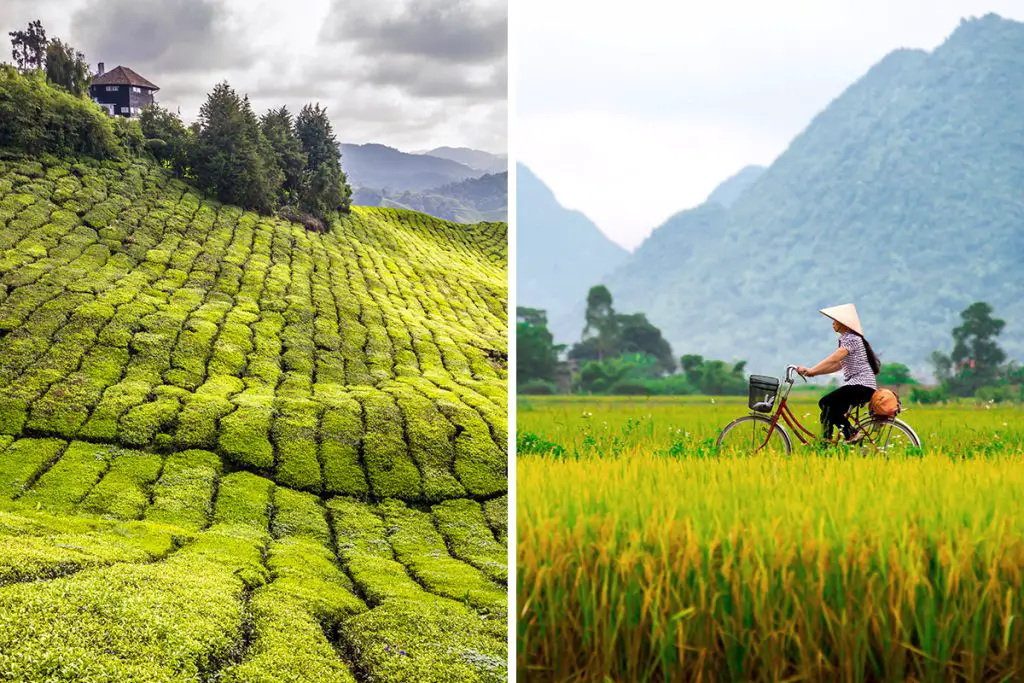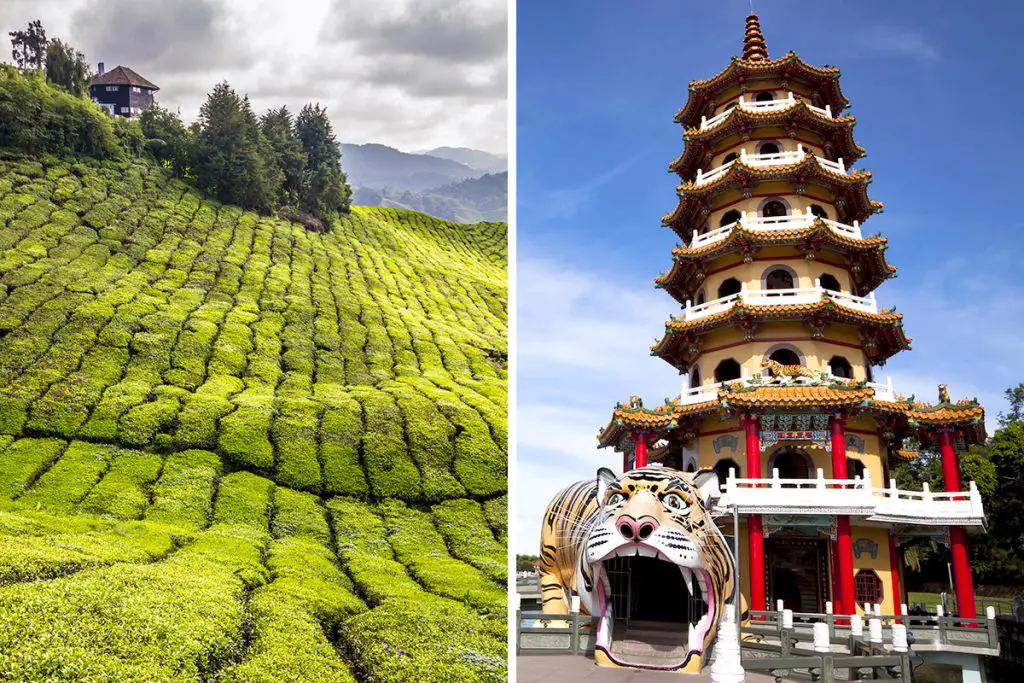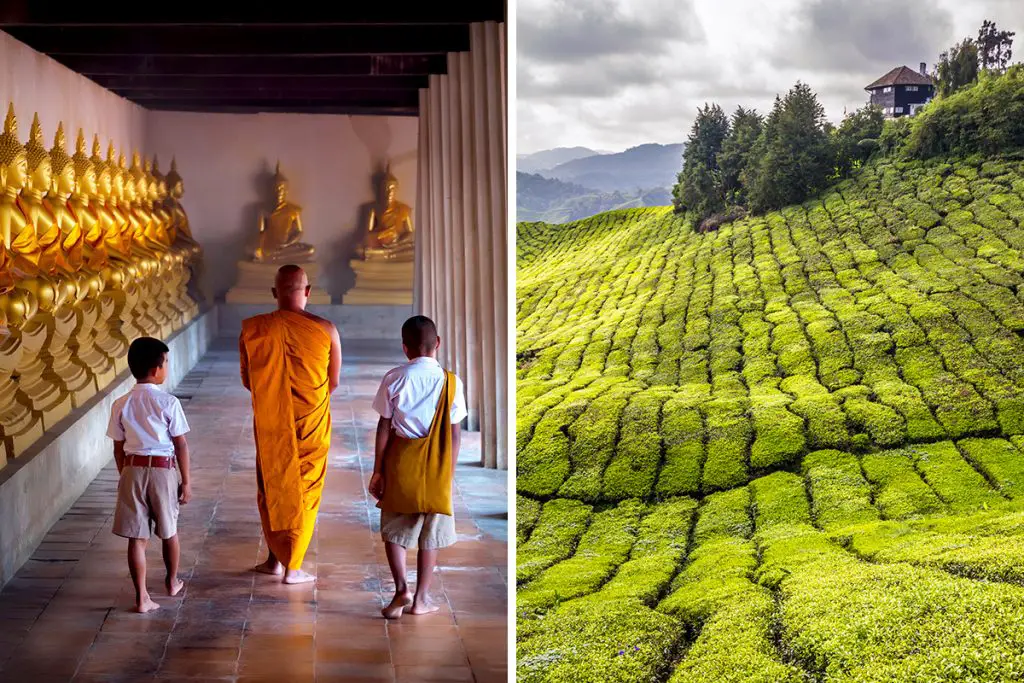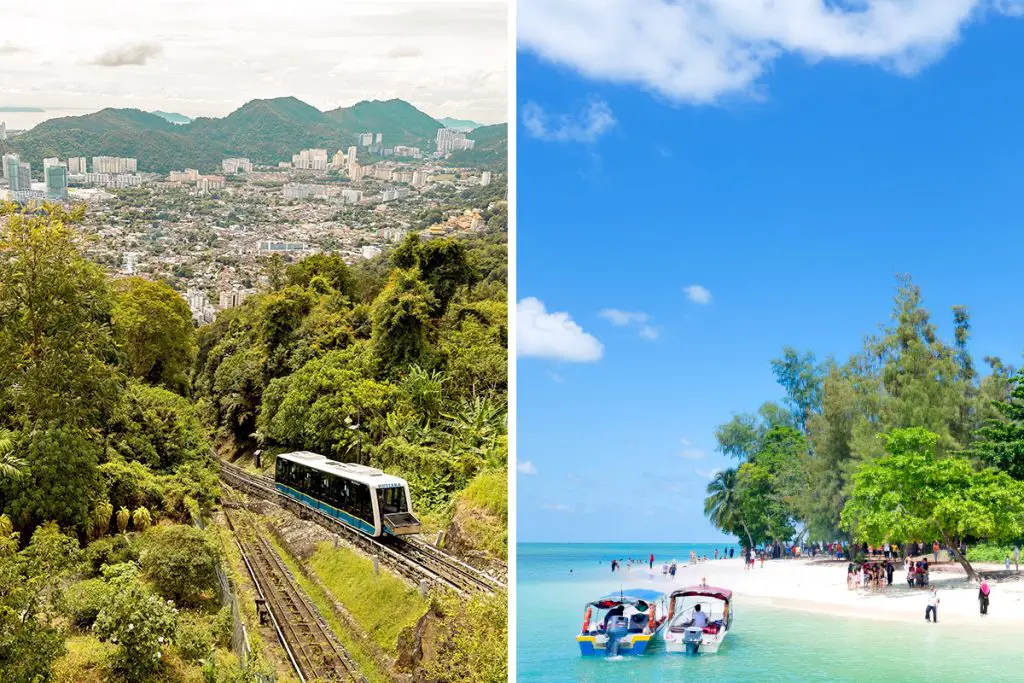Both countries have something special that makes them worth your time and money. Malaysia blends modern skyscrapers with ancient mosques and temples. The Philippines, on the other hand, offers more than 7,000 islands to explore, each with its own charm. Are you ready to dive deeper and find out which one suits your travel cravings best?
History & Culture
First off, let’s take a look at the histories and cultures of Malaysia and the Philippines. These are key parts of what makes each country unique and can help you decide where you’d like to visit.
In Malaysia, you’ll find a mix of different Asian cultures. The country is a meeting point for people from China, India, and indigenous Malay communities. This has led to a rich and diverse culture where you’ll see Chinese dragon dances, Indian temples, and Malay festivals all in one place.
Malaysia was also a British colony, so you can find English influences, like cricket and afternoon tea, here too.
The Philippines has a different blend of cultures and its history is like a tapestry with threads from Spain, the United States, and native Filipino tribes.
The country was a Spanish colony for more than 300 years, so you’ll see Catholic churches and Spanish names everywhere. Then, it was under American rule for a while, which brought the English language and modern ways of life to the islands.
Comparing these two, Malaysia offers a more Asian-focused experience, while the Philippines shows a blend of Western and Asian cultures. Both have unique traditions and festivals that you’ll find nowhere else.
In Malaysia, think of the Muslim holiday of Hari Raya or the Hindu celebration of Diwali. In the Philippines, you have festivals like Sinulog, which honors a Catholic saint but also has native dances.
One thing both countries have in common is their respect for family and elders. Whether it’s a big family dinner in Malaysia or a town fiesta in the Philippines, you’ll feel a strong sense of community and tradition.
In summary, your choice between Malaysia and the Philippines could come down to what type of cultural experience you’re looking for. If you lean more towards a fusion of Asian cultures, Malaysia may be the destination for you. However, if a mix of Western and Asian influences catches your interest, the Philippines might be your ideal spot. Either way, you’re in for a fascinating journey through rich histories and vibrant cultures.
Attractions & Activities
When it comes to filling your travel itinerary with exciting attractions and activities, both Malaysia and the Philippines offer a wealth of options. These aren’t your run-of-the-mill tourist traps; they’re experiences that will stay with you for a lifetime. So let’s get into the nitty-gritty and see what each country has to offer.
In Malaysia, nature enthusiasts must make a beeline for the Cameron Highlands. Situated about 200 km (approximately 124 miles) from Kuala Lumpur, this hill station is known for its tea plantations and strawberry farms.
If heights and thrills are more your thing, don’t miss the Sky Bridge in Langkawi. Suspended about 700 meters (approximately 2,297 feet) above sea level, this pedestrian bridge offers breathtaking views.
For those interested in history, a visit to Penang’s Kek Lok Si Temple, one of the largest Buddhist temples in Southeast Asia, is a must.
Switching gears to the Philippines, the Banaue Rice Terraces are a marvel that you need to see to believe. Created over 2,000 years ago, these terraces are sometimes called the “Eighth Wonder of the World.” If you’re into diving, the Tubbataha Reefs Natural Park is a UNESCO World Heritage site and a diver’s paradise.
History buffs will also love Intramuros, the “Walled City” in Manila, built during the Spanish colonial period.
In essence, Malaysia leans more towards a combination of natural and man-made wonders, offering everything from lush highlands to awe-inspiring temples. The Philippines, meanwhile, presents a rich tapestry of natural landscapes, from intricate rice terraces to pristine diving spots. Each offers a different kind of thrill, a unique opportunity for exploration and discovery.
Beaches
Both Malaysia and the Philippines boast coastlines that would make any beach lover’s heart sing. If you’re keen on adding some sun, sea, and sand to your travel plans, you’ll want to know what each of these tropical paradises has in store.
Malaysia offers the serene beaches of Langkawi, an island located about 30 km (approximately 18.6 miles) off the mainland’s northwest coast. The waters here are calm and suitable for various water sports like jet skiing and parasailing.
Over on the east coast, you’ll find the Perhentian Islands, known for their coral reefs and diving spots. These islands are about 19 km (approximately 11.8 miles) from the northeastern coast of Peninsular Malaysia.
The Philippines doesn’t lag behind, offering its famous Boracay Island, which is about 315 km (approximately 195.7 miles) from Manila. Known for its powdery white sand, the island also has a variety of water activities like windsurfing and paddleboarding.
Then, there’s Palawan, an archipelago with multiple islands offering secluded beaches and excellent snorkeling opportunities.
Both countries offer exquisite beach experiences but in different flavors. Malaysia’s beaches are often adjacent to luxury resorts and tend to be more laid-back. The Philippines offers more variety, from the bustling Boracay to the peaceful and remote beaches of Palawan.
Eating, Drinking & Nightlife
Whether you’re a foodie, a party-goer, or just someone looking to unwind with a nice drink, Malaysia and the Philippines both offer distinct experiences to tickle your taste buds and enliven your nights. Let’s dig into what makes each of these countries a culinary and social hotspot.
Starting with eating, Malaysia is known for its spicy dishes and street food. The hawker centers in Penang and Kuala Lumpur offer you the chance to sample dishes like Nasi Lemak, a coconut rice dish, or Char Kway Teow, a stir-fried noodle delicacy.
The Philippines, on the other hand, is famous for its grilled meats and seafood. Lechon, a roasted pig, and Adobo, a savory stew, are must-tries. Both countries take pride in their desserts, with Malaysia offering treats like ‘Kuih’ and the Philippines serving up Halo-Halo, a mixed dessert with ice and various ingredients.
When it comes to drinking, Malaysia is a bit more reserved due to its Muslim-majority population. However, you can still find places to enjoy Teh Tarik, a frothy tea, or even some locally brewed beers.
The Philippines is more liberal in this regard, with a variety of local rums and beers like San Miguel being widely available. Both countries have their own unique twists on coffee, but the Philippines stands out with its brewed coffee known as ‘Kape Barako’.
Nightlife in Malaysia is vibrant in its major cities like Kuala Lumpur, where rooftop bars and nightclubs are aplenty. The Philippines has a more laid-back approach but still knows how to party. Boracay and Manila are known for their beach bars and live music venues, respectively, creating an atmosphere that’s hard to resist.
In summary, both Malaysia and the Philippines offer something for everyone when it comes to eating, drinking, and nightlife. If you’re looking for spicy foods and a more subdued drinking scene, Malaysia is your go-to. If grilled delights and a lively atmosphere for drinks catch your fancy, the Philippines should be on your list.
Shopping
If you love to shop, both Malaysia and the Philippines offer an array of options to keep you entertained. From local markets to modern malls, let’s see how each destination stacks up.
Malaysia is known for its high-end malls like the Suria KLCC in Kuala Lumpur, which houses brands like Louis Vuitton and Gucci. You can also find cultural gems like batik fabric and pewter goods in central markets.
The Philippines also has its share of upscale shopping with malls like Greenbelt in Makati offering international brands. However, for unique souvenirs, you can head to markets like the Greenhills Shopping Center to find local handicrafts and pearls.
In Kuala Lumpur, the Central Market is a popular spot for handmade crafts, while in Manila, Dapitan Arcade is well-known for home décor items and souvenirs. Both countries offer similar products like textiles and crafts but differ in style and material. Malaysia is the place for silk and batik, while the Philippines excels in woven goods and bamboo crafts.
Both Malaysia and the Philippines have their own version of “night markets” where you can find a variety of goods at reasonable prices. Malaysia’s Jalan Alor and the Philippines’ Divisoria Market are bustling areas that operate well into the evening, providing a unique shopping experience.
To wrap things up, if you’re looking for a more luxurious shopping experience with the option for cultural buys, Malaysia may suit you best. If you’re more interested in local crafts and bustling markets, the Philippines offers a wider variety. Both countries, however, offer a memorable shopping experience that can cater to various interests and budgets.
Accommodation
Picking the right place to stay can make or break your trip, and both Malaysia and the Philippines have their own take on hospitality. Let’s dive into the kinds of accommodation you can expect in each destination.
In Malaysia, you have a broad range of options, from eco-friendly resorts in the jungle to modern skyscraper hotels in bustling cities like Kuala Lumpur. If you prefer something traditional, homestays in villages offer you a taste of local culture.
On the flip side, the Philippines offers an island-resort experience, especially in places like Palawan and Boracay. Here, beachfront cabanas and overwater bungalows are quite common. Like Malaysia, the Philippines also offers city hotels and countryside inns.
While Malaysia tends to offer more in the way of luxury and modern amenities, the Philippines leans more towards natural settings and picturesque views. In the highlands of Malaysia, you’ll find cozy mountain resorts, while in the Philippines, mountain lodges in places like Baguio offer a different kind of retreat.
Both countries have a growing trend of boutique hotels that focus on a more personalized experience. Whether it’s an artsy hotel in Penang or a heritage house in Vigan, you have options that veer off the beaten path.
In summary, Malaysia offers a mix of modern comfort and traditional settings, while the Philippines gives you the beauty of nature with a side of local charm. Both offer unique and inviting places to rest your head, depending on what you’re looking for.
Family-Friendliness & Children’s Activities
Traveling with the family in tow? Both Malaysia and the Philippines offer a bunch of activities that kids and adults alike will love. Let’s examine what each destination has up its sleeve for family fun.
In Malaysia, you’ll find numerous theme parks and educational centers. Legoland Malaysia Resort is a hit among families, offering themed rides and shows. Kuala Lumpur has its own aquarium, Aquaria KLCC, which gives kids an underwater adventure.
Meanwhile, the Philippines is abundant in natural experiences like snorkeling and island-hopping tours. Whale shark watching in Oslob is a popular activity that fascinates kids.
Outdoor activities are plentiful in both countries. Malaysia has Genting Highlands, where families can enjoy indoor and outdoor theme parks. In the Philippines, you have eco-adventure parks in places like Subic, offering zip lines and treetop adventures.
Both countries also offer cultural activities suitable for families. In Malaysia, a visit to Sarawak’s cultural village provides interactive lessons in traditional arts and crafts. The Philippines has its own version with Nayong Pilipino, an outdoor cultural theme park.
In a nutshell, Malaysia leans more towards structured and educational activities for families, while the Philippines offers natural explorations and adventures. Both countries have something fun and educational to offer, so your family will have plenty of options for a memorable trip.
Getting There & Getting Around
So you’ve chosen your destination, but how do you actually get there and move around? Here’s a quick guide comparing travel logistics in Malaysia and the Philippines.
When it comes to getting there, both Malaysia and the Philippines are well connected by air. Malaysia’s main hub, Kuala Lumpur International Airport (KLIA), is about 45 km (28 miles) from the city center. The Philippines’ main airport, Ninoy Aquino International Airport (NAIA), is roughly 20 km (12.4 miles) from Manila’s center. Both airports serve numerous international flights.
Now, for getting around. Malaysia boasts an extensive rail network, including the Kuala Lumpur metro system. If you’re in Penang, you can get around by bus or even a funicular to reach the hilltops.
In contrast, the Philippines relies more on jeepneys and tricycles for short distances within cities. For longer trips, domestic flights are more common due to the archipelagic nature of the country.
In Malaysia, ride-hailing services like Grab are widespread and offer a convenient way to travel. The Philippines has similar services but also offers traditional taxis. In both countries, ferry services are available for island-hopping, but they are more prominent in the Philippines due to its many islands.
To sum it up, Malaysia offers efficient public transport and ride-hailing services, making it easier to travel longer distances. The Philippines focuses more on local transport methods and is best suited for short distances within cities and island-hopping. Both countries have their own unique transport systems that offer a range of options to fit your travel needs.
Weather
When it comes to travel, weather plays a huge role in shaping your experience. Let’s look at what the climate is like in Malaysia and the Philippines to help you pick the perfect time for your trip.
Malaysia experiences a tropical rainforest climate with high humidity throughout the year. Its capital, Kuala Lumpur, typically sees temperatures ranging from 77°F to 95°F (25°C to 35°C). The wet season is from November to March, so if you prefer to avoid the rain, aim for the drier months like June and July.
On the other hand, the Philippines has a tropical maritime climate. Manila, its capital, has temperatures ranging from 70°F to 95°F (21°C to 35°C). The dry season falls between November and April, while the wet season is from May to October.
Interestingly, both countries are located near the equator, but the Philippines tends to have more variations in weather due to its archipelagic nature. For example, the northern region experiences cooler temperatures, especially from December to February, while the southern areas are consistently warm.
If you’re a fan of beach activities, the Philippines might be the better option for you from November to April. However, if you enjoy rainforests and highlands, Malaysia offers a more consistent climate year-round, especially in places like the Cameron Highlands where the weather is cooler.
In summary, both Malaysia and the Philippines offer tropical climates, but with slight variations in seasons. Your choice would depend on the activities you wish to do and the kind of weather you prefer.
Safety
Safety is an essential factor to consider when choosing your travel destination. So how do Malaysia and the Philippines stack up in this regard?
In general, Malaysia is considered safe for tourists, with low rates of violent crime. However, petty crime like pickpocketing can occur in crowded areas. The Philippines also offers a mostly safe environment for tourists but has regions that are advised against visiting due to political instability.
On the topic of natural disasters, Malaysia is relatively free from any significant risks like earthquakes or hurricanes. The Philippines, however, is part of the Pacific Ring of Fire, making it prone to earthquakes and typhoons. It’s essential to stay updated on weather alerts if you’re visiting the Philippines.
Both countries have strong safety measures for tourists. In Malaysia, the tourist police are helpful and can be approached for any concerns. Similarly, the Philippines has a tourist assistance program that provides vital safety information and support.
In summary, while both countries are generally safe for tourists, they have different sets of risks. Malaysia is prone to petty crimes but is free from natural disasters, whereas the Philippines has some regions that should be avoided and are prone to natural disasters.
Cost
Budgeting for your trip is critical, and Malaysia and the Philippines offer different experiences at varying costs. Let’s dig into how much you might spend in each country.
In Malaysia, a meal at a mid-range restaurant could cost around 40 Malaysian Ringgit, which is approximately $8.50. Public transportation is relatively cheap, with a one-way ticket costing about 3 Ringgit or roughly $0.64. Accommodation can range from budget to luxury, but you can find a midrange hotel room for about $70.
In the Philippines, a similar meal might cost around 300–600 Philippine Pesos, which is about $5.30 – $10.60. Public transport, mainly jeepneys and tricycles, is even cheaper, costing around 15–30 Pesos or less than $0.27 – $0.53 for short distances. Accommodation can average $100 for a mid-range hotel.
While both countries are considered budget-friendly, the Philippines generally offers a slightly expensive experience, especially when it comes to food and lodging. Transportation costs are quite similar in both countries, but Malaysia has a more organized and extensive public transit system.
Which Is Better – Malaysia or the Philippines?
You’ve journeyed through an in-depth comparison of Malaysia and the Philippines, covering essential aspects from history and culture to safety and cost. Now, it’s time to wrap up your quest for the ultimate travel destination between these two vibrant countries.
History and culture are rich in both countries, but they differ in essence. Malaysia offers a fusion of various ethnic influences, making it a melting pot of traditions. The Philippines, meanwhile, carries a distinct cultural identity shaped by its history of colonization and natural landscape.
Both countries offer an enriching cultural experience, but your preference may tilt depending on your interest in diverse vs. distinct cultures.
When it comes to attractions and activities, Malaysia often appeals to those who love natural beauty like rainforests and highlands. The Philippines provides a different but equally thrilling set of options, especially for beach and water activity enthusiasts. Depending on your preferred outdoor adventures, you might lean toward one country over the other.
Beaches are another pivotal factor in making your decision. Malaysia provides consistent weather year-round for beachgoers. In contrast, the Philippines offers a more seasonal approach, with clearer waters and better beach conditions generally from November to April. The choice between the two would largely depend on when you plan to travel.
For food, drinks, and nightlife, Malaysia offers a wide range of options, featuring its multi-ethnic influences. The Philippines is not far behind, offering a unique island nightlife experience and delicious local cuisine. If you’re more into diverse culinary options, Malaysia might be the place for you, while the Philippines caters more to those who seek a unique local experience.
Safety measures are robust in both countries, but Malaysia slightly edges out due to its lower susceptibility to natural disasters. Cost-wise, both countries are budget-friendly, but Malaysia offers an even more economical option for travelers, especially when it comes to food and lodging.
In summary, Malaysia seems to be a better fit for those who are after a mixture of cultures and a versatile range of attractions including rainforests and highlands. The Philippines is more suited for those who love beaches, are looking for a cost-effective vacation, and want to dive deep into a unique cultural setting. Your ultimate choice will depend on what specific experiences you seek to have on your trip.

